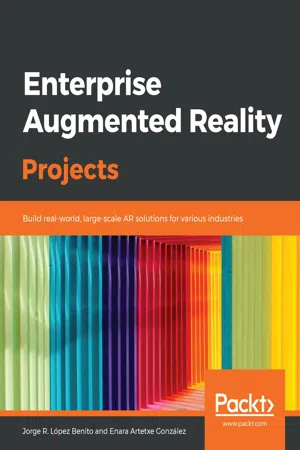
Enterprise Augmented Reality Projects
Build real-world, large-scale AR solutions for various industries
- 388 pages
- English
- ePUB (mobile friendly)
- Available on iOS & Android
Enterprise Augmented Reality Projects
Build real-world, large-scale AR solutions for various industries
About This Book
Design end-to-end AR solutions for domains such as marketing, retail, manufacturing, tourism, automation, and training
Key Features
- Use leading AR development frameworks such as ARCore, ARKit, and Vuforia across key industries
- Identify the market potential of AR for designing visual solutions in different business sectors
- Build multi-platform AR projects for various platforms such as Unity, iOS, and Android
Book Description
Augmented reality (AR) is expanding its scope from just being used in mobile and game applications to enterprise. Different industries are using AR to enhance assembly line visualization, guide operators performing difficult tasks, attract more customers, and even improve training techniques. In this book, you'll gain comprehensive insights into different aspects of developing AR-based apps for six different enterprise sectors, focusing on market needs and choosing the most suitable tool in each case.
You'll delve into the basics of Unity and get familiar with Unity assets, materials, and resources, which will help you build a strong foundation for working on the different AR projects covered in the book. You'll build real-world projects for various industries such as marketing, retail, and automation in a step-by-step manner. This will give you hands-on experience in developing your own industrial AR apps. While building the projects, you'll explore various AR frameworks used in the enterprise environment such as Vuforia, EasyAR, ARCore, and ARKit, and understand how they can be used by themselves or integrated into the Unity 3D engine to create AR markers, 3D models, and components of an AR app.
By the end of this book, you'll be well versed in using different commercial AR frameworks as well as Unity for building robust AR projects.
What you will learn
- Understand the basics of Unity application development and C# scripting
- Learn how to use Android Studio along with ARCore and Sceneform to build AR prototypes for Android devices
- Enable AR experiences on the web with ARCore and WebAR
- Explore emerging AR authoring tools such as Augmented Class! for education
- Understand the differences and similarities between handheld and head-mounted display (HMD) environments and how to build an app for each target
- Become well versed in using Xcode with ARKit and SceneKit to develop AR portals for iOS devices
Who this book is for
This book is for anyone interested in emerging and interactive technologies or looking to build AR applications for any domain. Although, no prior augmented reality experience is required, having some skills in object-oriented programming (OOP) will be helpful.
Frequently asked questions
Information
AR for Automation with Vuforia and AR Glasses

- Using AR in automation
- Exploring Vuforia
- Developing image-based AR in Vuforia
- Creating an industrial guide for AR glasses
Technical requirements
- A Unity 3D supporting computer (see the latest requirements here: https://unity3d.com/es/unity/system-requirements). This chapter's example project has been developed on a Windows 10 x64 computer.
- Unity 3D (2019.1.2f1 in this book).
- Microsoft Visual Studio Community 2017 (included in the Unity installation).
- The latest version of Vuforia included with Unity 3D (8.3.8 in this book).
- Epson Moverio BT-350 AR glasses.
Using AR in automation
Introducing the scenario and process
Table of contents
- Title Page
- Copyright and Credits
- Dedication
- About Packt
- Contributors
- Acknowledgments
- Preface
- Introduction to AR and How It Fits the Enterprise
- Introduction to Unity for AR Development
- AR for Manufacturing with ARCore
- AR for Training with WebAR and Augmented Class!
- AR for Marketing with EasyAR
- AR for Retail with Vuforia
- AR for Automation with Vuforia and AR Glasses
- AR for Tourism with ARKit
- Other Books You May Enjoy